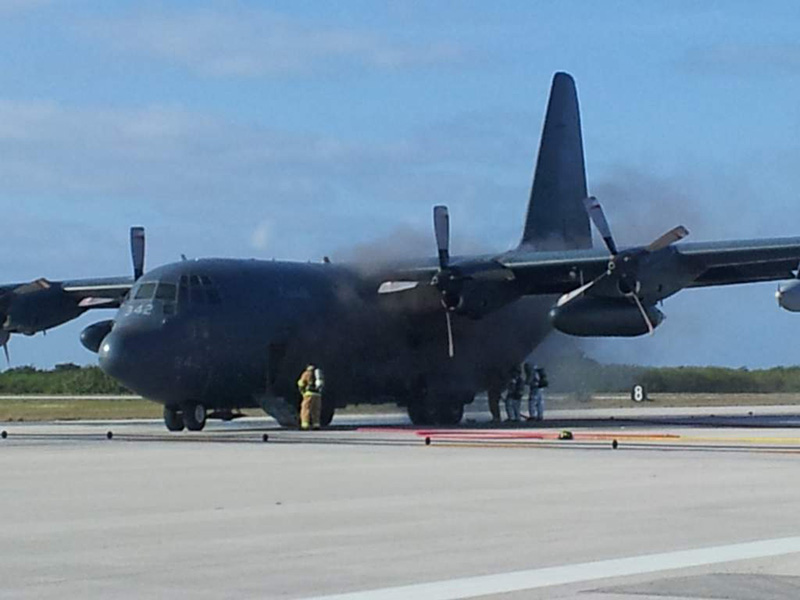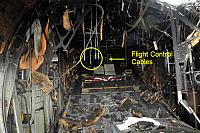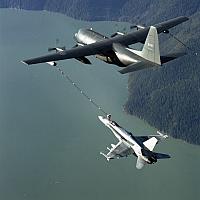C-130 News
C-130 Hercules News
Flight Safety report released for RCAF CC-130H incident at Key West
April 10, 2016 (by
Asif Shamim) -
The Canadian Armed Force have released the accident report for RCAF CC-130H #130342 Air Tanker which sustained damaged on February 21, 2012 during a deployment to NAS Key West in support of CF-188 fighter aircraft from 410th TFS.

During a touch and go at Naval Air Station Key West just prior to the aircraft becoming airborne, the Loadmaster, who was seated in the rear of the cargo compartment, heard an electrical buzzing sound and observed an orange jet-like flame shoot across the cargo ramp floor. He unbuckled his harness and was reaching for the fire extinguisher when an expansive orange fireball erupted, causing him to protect his head with his jacket. Once the fireball receded, he alerted the crew to the fire and moved forward to escape the heat and smoke.
Concurrent with the fire alert from the loadmaster, #130342 became airborne and reached a height of 10 feet in altitude above the runway. With sufficient runway remaining, the Pilot landed straight ahead and aggressively stopped the aircraft while the Co-Pilot notified Air Traffic Control. Once the aircraft came to rest and the engines were shut down, all nine crew members quickly escaped and moved upwind of the aircraft. Crash Fire and Rescue services responded and extinguished the fire. The aircraft was extensively damaged and one crew member received a minor injury.
The aircraft sustained “Category A” damage and was determined to be economically beyond repair.
The investigation determined that routing and clamping deficiencies in a modification to install ground test connections to the auxiliary hydraulic system, resulted in chafing between the hydraulic pump motor power wire and a pressurized hydraulic flexible hose. Electrical arcing between the wire and the hose resulted in a pin-hole breach of the flexible hose, release of hydraulic fluid under high pressure, and initiation of the fire.
Preventive measures included redesign of the modification, as well as changes to the modification process to include specialist review of wiring and hydraulic lines to ensure proper routing, support and protection from chafing, abrasion, harsh environments and damage from anticipated hazards. Preventive measures also included measures to educate and create awareness of the hazards associated with chafing.
A number of collateral observations were made and preventive measures recommended, including use of the dual layer principle for aircrew fire protection, policy for maintenance technicians flying as crew members, and improving communication between airworthiness authorities when imposing and lifting operational restrictions

Fire fighters deal with the fire which broke out in the interior of RCAF CC-130H #130342 on February 21, 2012. [Photo RCAF]
Concurrent with the fire alert from the loadmaster, #130342 became airborne and reached a height of 10 feet in altitude above the runway. With sufficient runway remaining, the Pilot landed straight ahead and aggressively stopped the aircraft while the Co-Pilot notified Air Traffic Control. Once the aircraft came to rest and the engines were shut down, all nine crew members quickly escaped and moved upwind of the aircraft. Crash Fire and Rescue services responded and extinguished the fire. The aircraft was extensively damaged and one crew member received a minor injury.
The aircraft sustained “Category A” damage and was determined to be economically beyond repair.
The investigation determined that routing and clamping deficiencies in a modification to install ground test connections to the auxiliary hydraulic system, resulted in chafing between the hydraulic pump motor power wire and a pressurized hydraulic flexible hose. Electrical arcing between the wire and the hose resulted in a pin-hole breach of the flexible hose, release of hydraulic fluid under high pressure, and initiation of the fire.
Preventive measures included redesign of the modification, as well as changes to the modification process to include specialist review of wiring and hydraulic lines to ensure proper routing, support and protection from chafing, abrasion, harsh environments and damage from anticipated hazards. Preventive measures also included measures to educate and create awareness of the hazards associated with chafing.
A number of collateral observations were made and preventive measures recommended, including use of the dual layer principle for aircrew fire protection, policy for maintenance technicians flying as crew members, and improving communication between airworthiness authorities when imposing and lifting operational restrictions
Courtesy of RCAF
Related articles:
External link:
Forum discussion:
Tags
- Last RCAF CC-130E heads to the museum (2016-04-05)
- Cascade Aerospace delivers 100th CC-130 to the RCAF (2015-04-07)
- C-130 Fighting Falcon news archive
External link:
Forum discussion:
- Start a discussion about this article in the C-130.net forum.
Tags



